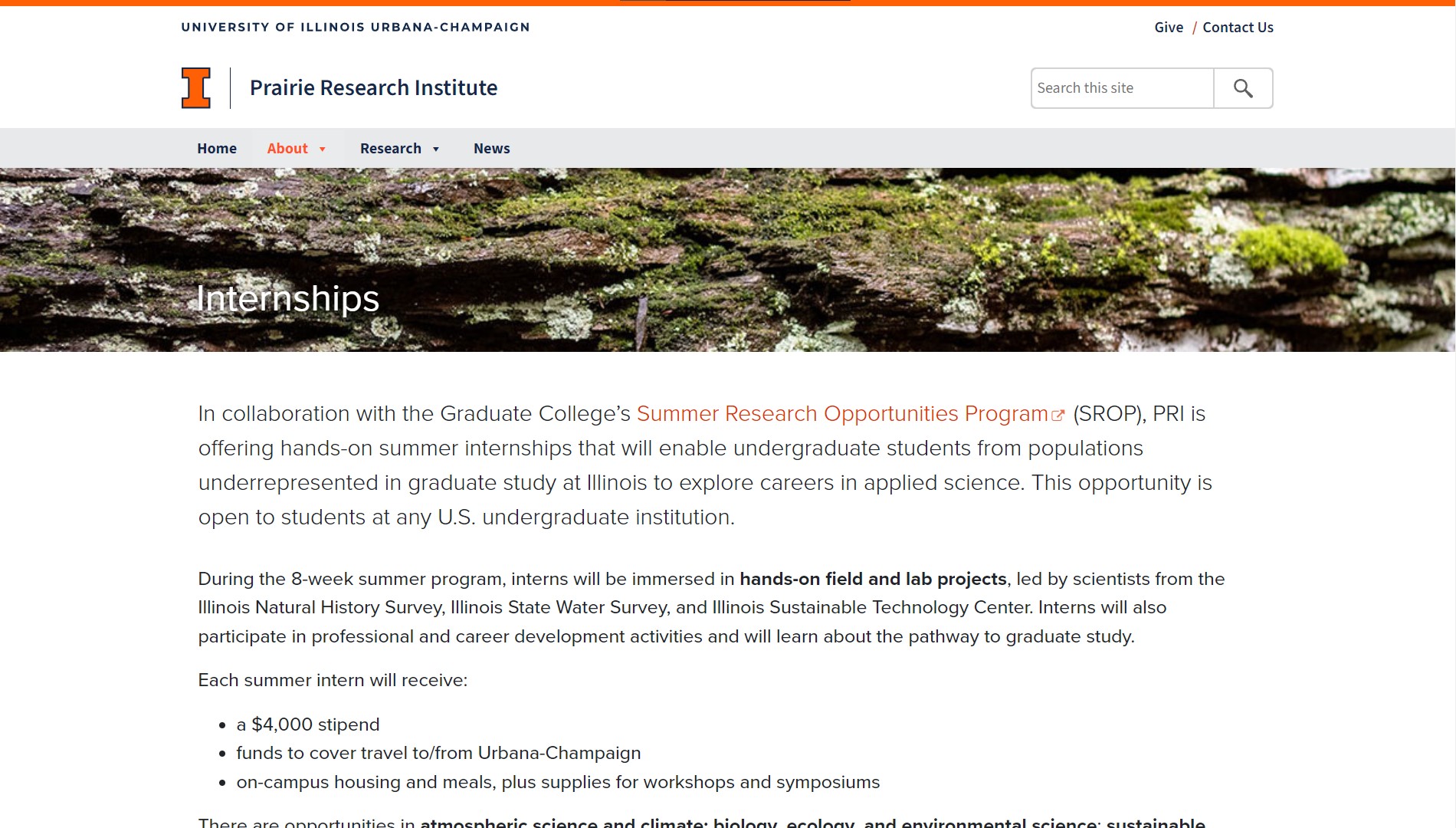
Summer Internship Opportunity at University of Illinois
In collaboration with the Graduate College’s Summer Research Opportunities Program (SROP), the Prairie Research Institute at the University of Illinois is offering hands-on summer internships that will enable undergraduate students from populations underrepresented in graduate study at Illinois to explore careers in applied science. This opportunity is open to students at any U.S. undergraduate institution.
During the 8-week summer program, interns will be immersed in hands-on field and lab projects, led by scientists from the Illinois Natural History Survey, Illinois State Water Survey, and Illinois Sustainable Technology Center. Interns will also participate in professional and career development activities and will learn about the pathway to graduate study.
Each summer intern will receive:
• a $4,000 stipend
• funds to cover travel to/from Urbana-Champaign
• on-campus housing and meals, plus supplies for workshops and symposiums
There are opportunities in atmospheric science and climate; biology, ecology, and environmental science; sustainable energy; and water supply and safety.
To learn how to apply, click here. The application deadline is Friday, March 3, 2023.
Select Summer 2023 Programs
Improved Lidar Observations of Atmospheric Turbulence
Dave Kristovich, PhD
Illinois State Water Survey, Prairie Research Institute, University of Illinois Urbana-Champaign
One of the major ways that the environment at one location can be impacted by pollutants released into the air from remote surface sources is through long-distance transport by winds at high altitudes in the atmosphere. Even though many sources are close to the ground (e.g., vehicles, factories, etc.), atmospheric motions (updrafts, downdrafts, turbulence) readily move pollutant gases and particles upward to higher altitudes. The UIUC/PRI/ISWS scanning Doppler atmospheric lidar can observe these atmospheric motions on an exceptional high-resolution temporal and spatial resolution. The UIUC/PRI/ISWS lidar is scheduled to be upgraded to allow for much-improved observations of air motions and turbulence. These improved observations, in combination with a nearby source of smoke, provides us an unprecedented opportunity to quantify relationships between atmospheric dispersion and the atmospheric motions that are responsible. The SROP student will help our research group evaluate the quality of the new observations to support future field projects. This research opportunity will allow the student to take field lidar observations over one to two 5-day periods, analyze the observations to quantify updraft/downdraft motions in the lower atmosphere, improve understanding of the new turbulence observations and relate these to dispersion and movement of a nearby smoke release. We hope also to have the opportunity to observe the beginning stages of development of deep convection due to the observed air movements. Note that if there are difficulties or delays in upgrading the lidar system, the student will have the opportunity to do most of this work using already-collected observations.
Implementing HAWQS for Hydrologic Modeling of a Watershed in Illinois
Elias Getahun, PhD
Illinois State Water Survey, Prairie Research Institute, University of Illinois Urbana-Champaign
The Hydrologic and Water Quality System (HAWQS) Version 1.0 is a web-based interactive water quantity and water quality modeling system that can assist states, local governments, and others with water quality protection decision-making. The core modeling engine of HAWQS is the Soil and Water Assessment Tool (SWAT), which is one of the most widely applied, public domain models. HAWQS provides users with interactive web interfaces and maps; pre-loaded input data; outputs that include tables, charts, and graphs; a user’s guide; and online development, execution, and storage of a user’s modeling projects. Under the investigator’s guidance, the undergraduate student will conduct the following activities: (1) learn how to set up watershed models using HAWQS, (2) develop a HAWQS model for one of the watersheds in Illinois, (3) learn how to conduct hydrologic model calibration and validation, (4) set up climate change scenarios and evaluate its hydrologic impact on the watershed and (5) prepare a poster presentation of this research. This summer research opportunity will provide the student with watershed modeling skills that will be essential for future research work involving watershed studies.